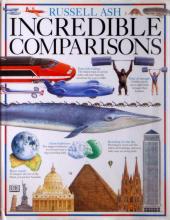Technology and Inventions
Incredible Comparisons
This picture book designed for "big kids" gives side-by-side comparisons according to length, height, area, life-span, speed, etc. of all kinds of things – animals, mountains, countries, modes of transportation, man-made structures and much more.
Segments of the book include: "On the Surface" (compares land-size of various countries, islands, different uses of land), "Into the Earth" (canyon depths, cave lengths and depths, etc.), "Going into Space" (compares power and speeds of rockets vs. airplanes, comet tail size comparison with various planets, etc.), "The Solar System" (compares planet sizes and distances, etc.), "Great Lengths" (compares lengths of airplanes, highways, major rivers, telecommunications cables, etc.). Other chapters cover animal speeds, land and water speeds, human population etc.
Does include some environmental and politically correct content. The segment on human population was much better than I expected, though. To give a sampling....
A population explosion has seen the number of people in the world more than triple since 1900 – from less than 2,000,000,000 to close to 6,000,000,000. Each day, enough people to fill the largest stadium in the modern world are added to the total. Thankfully, the world is a very big place. All the people in the world today could actually fit, standing shoulder to shoulder, on the small Indonesian island of Bali.
Trains
I really like it when authors of children's books remember that details of how things work are fascinating to children. Gail Gibbons is definitely one of those authors. Her book is filled with very simple illustrations and text about trains, but the various parts of the trains are labeled and the text explains things like how the trains link together and the differences between gondola cars, hopper cars, boxcars and tank cars.The back page contains a chart of signs and signals relating to trains. Appropriate for preschool or kindergarten age children.


